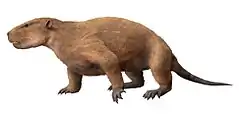| Vintana Temporal range: Maastrichtian ~ | |
|---|---|
 | |
| Life reconstruction of Vintana sertichi. Postcranial reconstruction is hypothetical. | |
| Scientific classification | |
| Domain: | Eukaryota |
| Kingdom: | Animalia |
| Phylum: | Chordata |
| Class: | Mammalia |
| Family: | †Sudamericidae |
| Genus: | †Vintana Krause et al., 2014 |
| Species: | †V. sertichi |
| Binomial name | |
| †Vintana sertichi Krause et al., 2014 | |
Vintana sertichi is an early groundhog-like mammal dating from the Late Cretaceous, approximately 66 million years ago. Scientists found the lone fossil, a skull, on Madagascar's west coast in the Maastrichtian Maevarano Formation.
Vintana is extremely relevant to the understanding of gondwanatheres because it is the first well-preserved skull, as opposed to previous fragments and teeth. Establishing a connection with multituberculates and haramiyidans in the theriiform clade Allotheria, it is a rather unusual animal, possessing massive lateral flanges in its skull whose exact purpose is poorly understood, as well as massive olfactory bulbs. A rather large animal at a weight of 19 pounds (8.74 kg), Vintana also represents another example of a considerably large Mesozoic mammal alongside Adalatherium, other gondwanathere from same formation, this body mass is only exceeded by Repenomamus.[1][2][3][4]
See also
References
- ↑ Krause, David W.; Hoffmann, Simone; Wible, John R.; Kirk, E. Christopher; Schultz, Julia A.; von Koenigswald, Wighart; Groenke, Joseph R.; Rossie, James B. (2014-11-05). O'Connor, Patrick M., Seiffert, Erik R., Dumont, Elizabeth R., Holloway, Waymon L., Rogers, Raymond R., Rahantarisoa, Lydia J., Kemp, Addison D., Andriamialison, Haingoson. "First cranial remains of a gondwanatherian mammal reveal remarkable mosaicism". Nature. Nature Publishing Group, a division of Macmillan Publishers Limited. 515 (7528): 512–517. Bibcode:2014Natur.515..512K. doi:10.1038/nature13922. ISSN 1476-4687. PMID 25383528. S2CID 4395258.
- ↑ Drake, Nadia (November 5, 2014). "Fossil From Dinosaur Era Reveals Big Mammal With Super Senses". nationalgeographic.com. National Geographic Society. Archived from the original on November 5, 2014. Retrieved November 5, 2014.
- ↑ Wilford, John Noble (November 5, 2014). "Fossil's Unusual Size and Location Offer Clues in Evolution of Mammals". New York Times. Retrieved November 6, 2014.
- ↑ Krause, David W.; Hoffmann, Simone; Hu, Yaoming; Wible, John R.; Rougier, Guillermo W.; Kirk, E. Christopher; Groenke, Joseph R.; Rogers, Raymond R.; Rossie, James B.; Schultz, Julia A.; Evans, Alistair R.; von Koenigswald, Wighart; Rahantarisoa, Lydia J. (2020). "Skeleton of a Cretaceous mammal from Madagascar reflects long-term insularity". Nature. 581 (7809): 421–427. doi:10.1038/s41586-020-2234-8. ISSN 1476-4687. PMID 32461642. S2CID 256822209.
External links
 Data related to Vintana at Wikispecies
Data related to Vintana at Wikispecies

